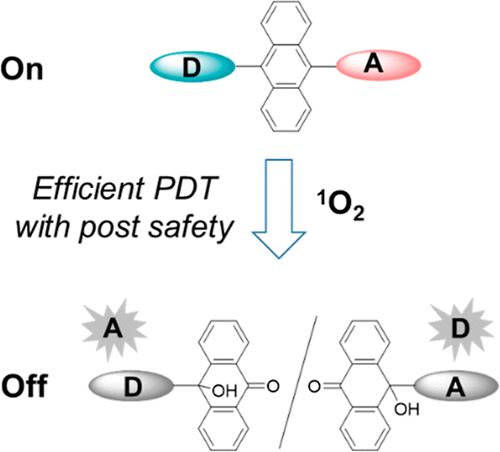当前位置:
X-MOL 学术
›
Chem. Mater.
›
论文详情
Our official English website, www.x-mol.net, welcomes your
feedback! (Note: you will need to create a separate account there.)
Anthracene-Bridged Photosensitizers for Effective and Safe Photodynamic Therapy
Chemistry of Materials ( IF 7.2 ) Pub Date : 2023-01-19 , DOI: 10.1021/acs.chemmater.2c03274 Jucai Gao 1 , Hui Yang 1 , Yaru Lu 2 , Qiankun Shi 1 , Shidang Xu 3 , Wenbo Wu 2 , Fang Hu 1 , Bin Liu 3
Chemistry of Materials ( IF 7.2 ) Pub Date : 2023-01-19 , DOI: 10.1021/acs.chemmater.2c03274 Jucai Gao 1 , Hui Yang 1 , Yaru Lu 2 , Qiankun Shi 1 , Shidang Xu 3 , Wenbo Wu 2 , Fang Hu 1 , Bin Liu 3
Affiliation

|
Photodynamic therapy (PDT) is a minimally invasive therapeutic modality. However, the residual photosensitizers (PSs) after PDT can still produce toxic singlet oxygen (1O2) under sunlight to damage normal tissues. The PS that can be switched off after PDT is desirable but rare. Herein, we propose a general strategy to design effective and self-degradable PSs by embedding an anthracene bridge into donor–acceptor (D–A) structures. First, the steric anthracene can regulate the orbital distribution for enhancing the 1O2 production capacity. More importantly, the anthracene is responsive to the self-produced 1O2 for self-degradation. Besides, the degradation rate can be fine-tuned by the hydrophilicity of PSs. In this way, the PSs can realize a balance between treatment and suicide to ensure PDT and post-treatment safety. This work provides new insights into the design of degradable PSs with a clear mechanism, aiming to improve the post-safety of PDT.
中文翻译:

用于有效和安全光动力疗法的蒽桥接光敏剂
光动力疗法 (PDT) 是一种微创治疗方式。然而,PDT后残留的光敏剂(PSs)在阳光下仍会产生有毒的单线态氧( 1 O 2 ),对正常组织造成损伤。PDT 后可以关闭的 PS 是可取的,但很少见。在此,我们提出了一种通用策略,通过将蒽桥嵌入供体-受体 (D-A) 结构来设计有效且可自降解的 PS。首先,空间蒽可以调节轨道分布,提高1 O 2 的生产能力。更重要的是,蒽对自产的1 O 2为了自我贬低。此外,降解速率可以通过 PS 的亲水性进行微调。通过这种方式,PSs 可以在治疗和自杀之间实现平衡,以确保 PDT 和治疗后的安全。这项工作为具有明确机制的可降解 PS 的设计提供了新的见解,旨在提高 PDT 的后安全性。
更新日期:2023-01-19
中文翻译:

用于有效和安全光动力疗法的蒽桥接光敏剂
光动力疗法 (PDT) 是一种微创治疗方式。然而,PDT后残留的光敏剂(PSs)在阳光下仍会产生有毒的单线态氧( 1 O 2 ),对正常组织造成损伤。PDT 后可以关闭的 PS 是可取的,但很少见。在此,我们提出了一种通用策略,通过将蒽桥嵌入供体-受体 (D-A) 结构来设计有效且可自降解的 PS。首先,空间蒽可以调节轨道分布,提高1 O 2 的生产能力。更重要的是,蒽对自产的1 O 2为了自我贬低。此外,降解速率可以通过 PS 的亲水性进行微调。通过这种方式,PSs 可以在治疗和自杀之间实现平衡,以确保 PDT 和治疗后的安全。这项工作为具有明确机制的可降解 PS 的设计提供了新的见解,旨在提高 PDT 的后安全性。











































 京公网安备 11010802027423号
京公网安备 11010802027423号